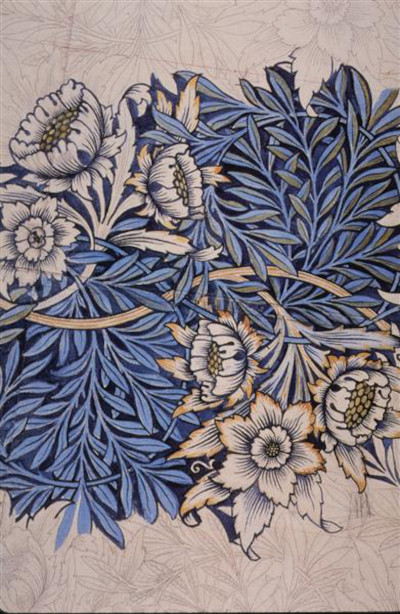This delightful design by William Morris features tulips and willow. We believe that he put this item together in 1873 with the intention of turning it into wood-block printed fabric. He was passionate about using traditional artistic techniques and gained respect for avoiding some of the growing interest in mass production.
19th century Britain was heavily impacted by the Industrial Revolution and the art world was no different to that. Morris and his colleagues would reject these ideas about profitability and ease of production, and attracted patrons by offering them only the finest quality available. They covered a good breadth of skills between them and could take on almost any artistic request. The tulip and willow design shown here could have been entirely taken on by Morris himself, though, as it would have just involved illustration followed by printing to fabric, which were both comfortable requests for him. Morris was a master of floral patterns and these could be translated across a number of different mediums, including the likes of wallpaper and furniture covers. Soon enough there would be a huge clamour for these designs, and many successful artworks would be reproduced several times over, though still by hand each time. This version was prepared for wood block printing and included orange and blue tones alongside the floral outlines.
The artist became familiar with plants and flowers, making use of a good number of different species as inspiration for his work. Some would hold symbolic values, such as the lilies which represented purity within religious settings, whilst others might refer to a particular season in which they would bloom. In other cases it would simply be about their aesthetic value, such as the shape of the flower head or the colours that they could bring to a particular design. One can see many different flowers appearing across his output of designs for furniture, fabrics and more, and these contemporary styles feel entirely suitable today, a good century or so later. Relatively little is known about tulips and willow, but the date of 1873 does help us to place it within the context of his overall career. Morris himself would become known as one of the most influential British artists in history and came about during an important period, during which the nation's artistic output was perhaps at its peak.
The best place to see more of this artist's work would probably have to be the V&A Museum in central London, UK. They have a fine selection of his designs available here and have put side a specific part of the building in which to show it off. The style of Morris feels particularly British and his levels of innovation, combined with incredible technical expertise, make him someone to be proud of. Over time his approach has become well known all across the world and influenced international artists all the way up to the present day. Even now one can imagine getting reproductions of his work within our own homes, either as wallpaper designs or perhaps some curtains. He also played a role in reminding us of the negative aspects of mass production, which are particularly worth remembering in today's world.




